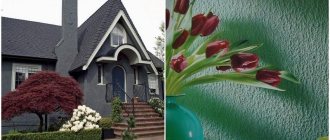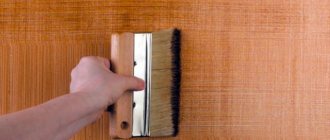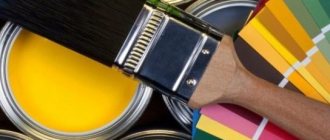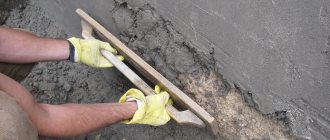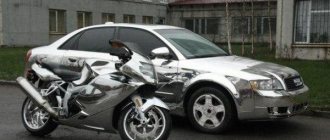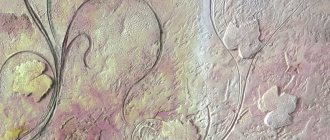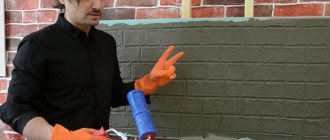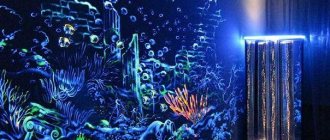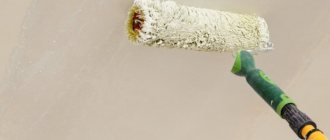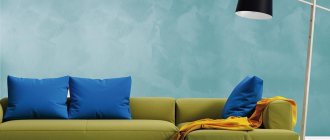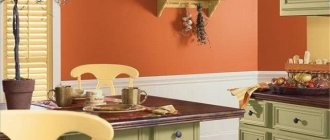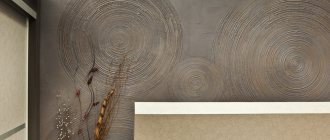Description of material
Paint for relief painting of walls is a thick solution. It is very viscous. The coating is based on an acrylic binder. Options for mineral binders, as well as silicone, are possible. They contain certain fillers that are responsible for the texture of the wall. Textured enamel is easy to apply, the process will not take much time even for a beginner.
You can choose white paint or colored paint. If a person prefers a mineral composition, then it is better to buy a dry mixture. To prepare the solution, it must be diluted with water. This type of coating is ideal for working on facades.
Many people do their own relief painting of walls using water-based paint. This type of coating can be purchased in white and tinted with your favorite pigment yourself. The result is a wall covering that resembles decorative plaster.
What types of fillers are there and what sizes?
To make the paint thicker and create a relief, special particles are added to it. Regardless of what type of structural paint was chosen for the walls, there is always one advantage - good water resistance.
The following types with fillers are distinguished:
- Marble chips. Granite looks no less impressive.
- Fine gas silicate is popular these days.
- Quartz sand is suitable for many interiors.
- Metal particles that reflect light will decorate the walls of living rooms.
- Sawdust or shavings.
- Natural fibers. Synthetic ones are also used to cover walls.
Manufacturers use various thickeners. Some add a special type of starch and pigments. The result is the effect of silk walls that shine with mother-of-pearl.
Particle shapes also vary. They can be in the form of scales or drops. The depth of the relief will be determined by the size of the particles.
Relief paints for walls are:
- Fine-grained. Their filler diameter is 0.5 millimeters.
- Medium grain. They have a filler diameter from 0.5 millimeter to 1 millimeter.
- Coarse-grained. They have particles with a diameter of 1 to 2 millimeters.
What surfaces are textured paints intended for?
Embossed wall paint can be used for exterior and interior decoration. The scope of application depends on the composition of the coating. It is important to strictly follow all manufacturer's recommendations.
Textured paint can be applied to wooden surfaces, as well as to plastered walls. It can be used on concrete and masonry. It is possible to paint the stone surface.
Popular paint manufacturers
Many companies both abroad and in Russia are engaged in the production of textured paints. Among the most famous are:
- Amourcolor . A wide range of color and relief options are available;
- Perlata . Textured paints filled with mica and mineral particles. Has a pearlescent effect;
- Blanccolor . A French company offering a range of decorative plaster compositions and textured paints;
- Clavel . American manufacturer producing elite types of paint and varnish coatings;
- Lakra . A Russian company that produces various compositions with “wet silk”, “Mizuri” and other types of relief. Users note high quality and reasonable prices;
- VGT . Another Russian manufacturer offering high-quality and inexpensive finishing materials.
Only a few well-known manufacturers are listed, whose products are most often found on store shelves.
What determines the price of coverage?
The price of relief paint for walls depends on what type of binder is used to produce the coating, as well as on the type of filler. If the paint contains unique additives, the price will be higher than that of enamel with a conventional composition. Color also affects the cost of the product. Popular shades are usually overpriced. The cost of the material differs in different construction stores.
For the average consumer, the price of relief paint for walls at Leroy Merlin will be affordable. This network has a large assortment of different shades. Prices range from 1,500 to 9,500 rubles per jar. It is better to buy a product from well-known manufacturers and not skimp on quality paint.
How to make a textured coating with your own hands?
Many citizens want to save on coating costs and try to make textured paint themselves using scrap materials. In order for the composition to be of good quality, you need to correctly observe the proportions of the ingredients and follow the step-by-step instructions:
- You need to buy acrylic paint.
- You need to add sawdust and granite chips to it. Quartz sand is also required.
- The mixture needs to be stirred. The number of constituent elements will depend on where the paint will be used. The composition for the facade will be different from the composition for interior decoration.
Types of textured compositions
As structural paint options, you can buy mixtures that give the walls a unique design:
- Relief - obtained by adding quartz chips, sawdust or other granules to the paint.
- Atacama is an option when a velvet surface with uneven painting is formed on the wall. The composition includes metal particles and quartz sand, which have reflective properties.
- Marseille wax is an imitation of stone obtained by applying wax paint on top.
“Atacama” - paint interspersed with quartz sand and metal pigments
Preparatory stage of working with textured paint
Before applying textured wall paint with your own hands, the walls need to be leveled using a building level. It is not necessary to fix small cracks on the surface. How to apply textured wall paint with a roller yourself? The material will be applied in a thick layer, defects will be reliably hidden. The relief surface is great for veiling minor damage to walls.
It is important that the surface is durable. Pieces of plaster should not fall off. It is necessary to ensure strong adhesion of the paint to the surface. To do this, it is better to prime the wall. For this stage of work, it is better to purchase the material that is marked “deep penetration primer”. It must have an identical base with the paint.
What application methods are there?
For textured paints, you can use different application methods and different tools. The following methods are distinguished:
- Using a brush, brush. It is necessary to apply a layer of paint to a surface with an area of 1.5-2 square meters. Lines are drawn on the wall with a large brush. The direction is chosen arbitrarily. You can even make waves. The result is an unusual drawing. You can create unique surfaces.
- The method using a comb is needed to obtain a more pronounced relief.
- Method using a spatula. It is necessary to apply a thin layer of paint to the surface, then use a spatula to make sparse strokes. The application technique is quite rough. The shape of the strokes resembles stones. It will be difficult for a person who has never worked with this method to do an entire wall alone. In this case, it is better to turn to professionals.
- Using a roller. You need to take a roller with a fur “coat” or foam rubber. Paint is applied to the wall in a thin layer, after which you need to roll over the surface until the paint has dried. The result is a rough wall surface. The pattern depends on the type of roller.
- Using a figured roller will help you create an unusual pattern on the wall. The roller has a relief “fur coat”. His drawing is imprinted on the wall. When using this technique, you need to try to ensure that the drawing does not break off in the middle of the wall. It's better to continue it to the floor.
- Using a sponge or cloth rag will allow you to make some kind of stamps on the surface of the wall. The result is an unusual drawing. Some people make patterns using their fingers. It all depends on the person’s imagination and desire to get a unique room design.
Advantages and disadvantages
Textured paint for exterior work is popular primarily because it allows you to hide surface defects. If the wall being treated is in good condition, you will not have to additionally plaster it or remove the old coating from it. Of course, if the coating is peeling or already peeling off, then it is better to remove it, otherwise the new applied paint will peel off along with it.
Compared to conventional paint, textured paint is characterized by better resistance to mechanical stress. It is due to this that it is suitable for various surfaces, even those that are exposed to abrasives.
This paint can be used to paint surfaces made of:
- wood;
- drywall;
- bricks;
- concrete;
- plaster.
Due to the high vapor permeability rate, moisture will not be retained in the treated walls. Modern compounds are non-flammable, odorless and do not emit harmful elements into the air during operation. You don't need any special skills to paint the surface. If desired, patterns or reliefs can be easily created. Structural paint for facades is tinted, that is, it is mixed to achieve the desired shade. A popular domestic brand of textured composition is Latek L305.
Structural facade paint also has disadvantages:
- increased consumption - to paint 1 m2, up to 500 g of product is spent, where the layer thickness reaches 10 mm;
- high cost due to consumption and price of the paint itself;
- Due to the created irregularities, dust is deposited on the surface of the wall, so it will have to be cleaned more often.
Textured paint for the facade of a house is a high-quality and sought-after finishing material. And yet, it requires a certain skill during the work.
What are the advantages of textured paint?
Textured paint has a number of advantages over other surfaces:
- It can mask various defects on the wall. To obtain the desired effect, it is not necessary to putty the surface.
- The result is a uniform coating, without joints or seams.
- You can do the work yourself.
- Saving money that a person would have spent on paying for specialist services.
- Opportunity to create a unique room design.
- The coating can be used in a children's room, as the textured paint is resistant to mechanical damage.
- Increased moisture resistance of paint.
- Environmentally friendly product composition. The paint is not dangerous to human health and life.
Features of water-based paints
Water-based paint is, first of all, an opportunity to paint walls in a wide variety of shades.
Although its base color is white, it is perfectly colored with color additives, which create shades of varying brightness.
Coloring services are provided in many construction supermarkets, where specialists will offer several shade options of the same color and show how they will look on the wall. It will be possible to choose the most suitable one, taking into account the fact that the dried painted surface differs by 1-2 tones from the paint itself.
Expert advice! The color is introduced immediately into the entire required amount of the coloring composition, since it is almost impossible to repeat an already created color.
In addition to design possibilities, the water-based paint composition has several more advantages:
- absence of a pungent odor, and the one that exists “goes away” within a few hours;
- environmental friendliness;
- quick drying of painted walls;
- ease of application to the surface.
The disadvantages are minor, but they exist:
- work is performed at a temperature not lower than +50C;
- preliminary surface preparation;
- You need to immediately paint at least one wall completely, or better yet the entire room, so that everything has the same color.
They choose paint not only by color. There are several types of water-based paint mixtures:
- acrylic based on acrylic resin with good resistance to water. With the introduction of latex, this paint becomes resistant to treatment with simple detergents;
- silicone ones are obtained by introducing silicone resins and have high vapor permeability and adhesion;
- silicate ones are formed based on a combination of liquid glass and an aqueous solution;
- mineral ones, used for work on concrete and brick, have a short service life.
Note! You should not paint walls with a water-based emulsion based on slaked lime (mineral) in rooms with high humidity or in places where contamination with grease and soot is possible. Acrylic and silicone paints are better suited for such rooms.
What are the disadvantages of textured paint?
In addition to the advantages, this coating has its disadvantages. If people want to do a different type of wall covering, they will have to completely remove the embossed paint. This process will take a lot of time and effort. You cannot put wallpaper on a surface without removing the paint layer.
During operation, a large amount of material is consumed. A minimum of six hundred grams of paint is required per square meter. This value can increase to two kilograms, depending on the room. The cost of finishing is increasing all the time.
Criterias of choice
Due to the wide variety of texture dyes available on the market, the area of application must be taken into account when choosing this material.
For exterior decoration
To paint the facade, it is recommended to buy materials that can withstand:
- temperature fluctuations;
- direct sunlight;
- precipitation.
See also
Types of primers for OSB boards under wallpaper and rating of the best brands, how to apply
Such products include silicate and vinyl dyes. Mineral compositions can also be used when finishing external walls. But in this case it is necessary to mix the paint with special additives.
For interior decoration
When choosing finishing materials for interior spaces, you should be guided by the following recommendations:
- compositions with a velvet or silk effect are suitable for bedrooms and living rooms;
- for ceilings - compositions of light shades;
- for the bathroom - water-dispersed coatings;
- for the kitchen - washable dyes.
The type of effect that needs to be recreated on the surface is selected based on personal preferences.
Recommendations from professionals
Experts often give general advice on how to apply textured wall paint. You can use a brush when working. Textured paint for walls is applied with your own hands, either with a roller or with a spatula. It all depends on the preferences of homeowners.
To create an unusual relief, you can add sand to the paint during the preparation of the solution. River sand cannot be used for this type of finishing. You can add quartz to the solution. Some people mix paint with sawdust or small shavings.
In some cases, it is permissible to use a spray. It is important to be careful during the paint application process. It will be difficult for a person to control how thick the resulting layer is. You can use various stencils. It will be much easier for beginners to work with them.
If a person has never encountered these types of paint application, then it is recommended to practice on an unnecessary sheet of plywood or take a section of the wall that is not very noticeable. Experts recommend experimenting more with texture to understand what type is suitable for the desired room. It is necessary to understand the technique of applying relief and gradually hone your skills. In this case, you can get a unique wall covering with an original pattern.
Embossed wall paint will help add variety to the interior. You can make a bright facade or highlight one wall with this coating. An unusual solution would be a combination of different styles of material application. It is important to follow the application technique. You should not place furniture close to the wall immediately after painting. You need to let the surface dry completely. You can enjoy the results obtained for many years.
Using relief paints
Unlike decorative plaster, relief paints are more liquid and are applied in a thin layer, so they are easier to work with.
However, they are more demanding on the surface than plaster and can only be used to decorate well-leveled walls. They are applied using a trowel, spatula or roller, and after leveling, a pattern is created using various tools. This will be shown in more detail below in the video tutorials.
Textured paints, as a rule, have good adhesion, so they are used for different substrates:
- on wood;
- for metal;
- for plaster and concrete;
- for foam blocks and gas blocks;
- for drywall;
- for OSB and DSP;
- for plastic.
Facade painting
There are special requirements for paint and varnish coatings for facade finishing. They must have increased strength, be resistant to abrasion, mechanical stress, precipitation and temperature changes.
Silicone aqueous dispersions have all these advantages. Their cost is fully justified by the result - facades, plinths of houses, fences and balconies after painting receive a bright, original texture.
The introduction of latex liquid polymers gives acrylic paints additional strength and water resistance, which will allow them to be used for facade decoration.
Painted to resemble stone in two colors, the base of the house is finished with decorative plaster imitating stonework
For outdoor work, it is also possible to use less expensive, but quite durable styrene-acrylic copolymers.
The quality of the surface largely depends on the brand of the manufacturer. Textured paints VGT, Latek, Condor, Feidal Fassadenfarbe Relief, Dufa have proven themselves well.
The final coating of the finish with acrylic varnish will protect the facade from scratches, dust, moisture, and make the paint crack-resistant.
In the interior
Decorative relief mixtures are used to decorate the ceilings and walls of living rooms, kitchens, children's rooms, corridors, loggias, office and industrial premises.
Moreover, you can paint only part of the interior: columns, beams, pilasters, and create original drawings and compositions based on them.
In bathrooms and kitchens, it is better to use washable coatings to achieve textured surfaces.
Interior paint with fine relief
Popular Russian brands include paints from the German company Alpina and Lakra (Moscow region). The cost of Alpina expert materials is slightly higher, but there is no doubt about its quality. Lakra products are also at their best - the compositions are used even in places with high operational load - in halls, offices, on landings and flights.
